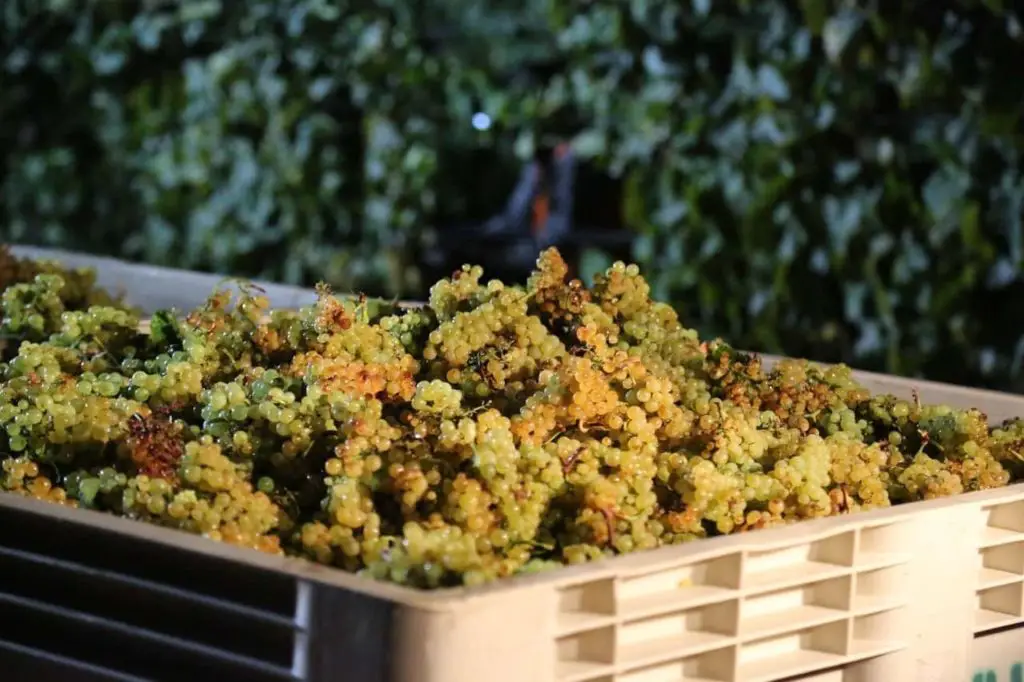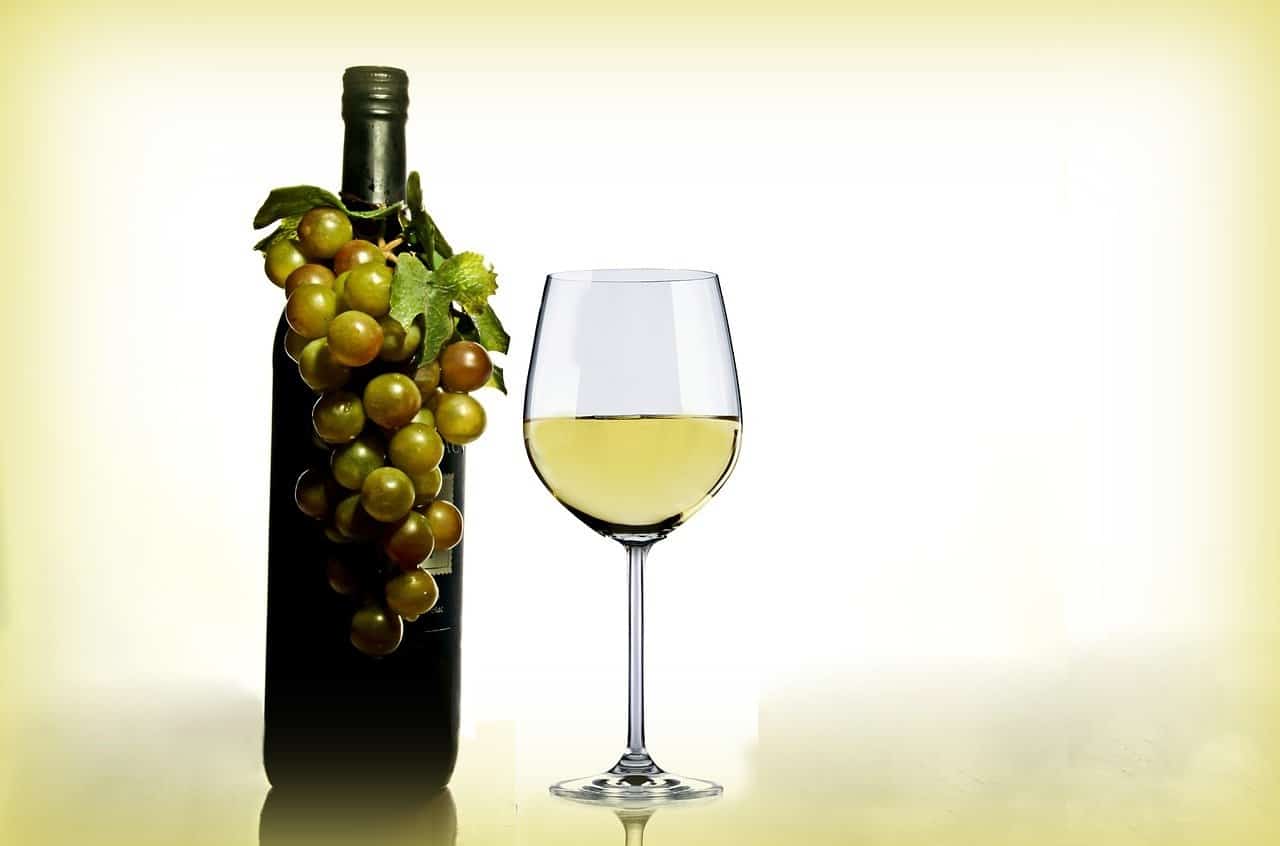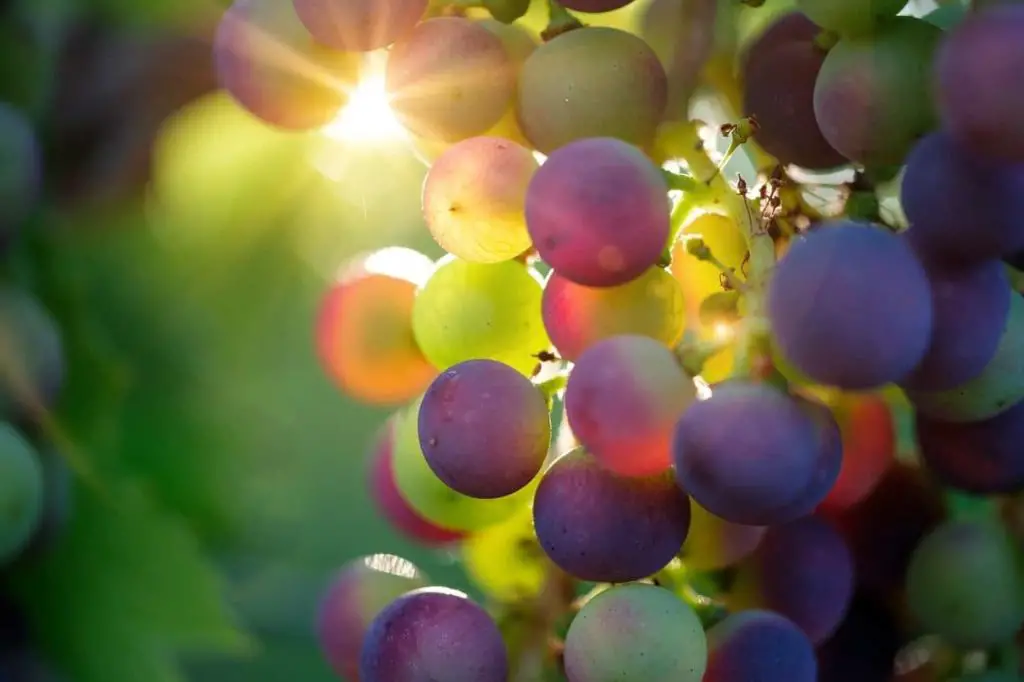Two of the most popular wines in the world are Chardonnay and Pinot Grigio, but which do you prefer? Perhaps you like them equally for their different qualities. They might go better with one food rather than another. As they are both white wines, they probably won’t go well with red meat, but white meat and fish are a perfect combination for either wine. In this article, we will tell you how they are made, their tastes and aromas, and what food they go best with.
The Main Differences Between Chardonnay vs Pinot Grigio
The grapes used to make Pinot Grigio are a greyish-blue colour, while Chardonnay comes from green-skinned grapes. Pinot Grigio is crisp, tart, and light while Chardonnay is creamy, particularly if it has been aged in oak barrels. Wine connoisseurs regard Pinot Grigio as more of a simple wine than Chardonnay, but that doesn’t mean that it is not a delicious wine.
All About Chardonnay
We will first take a look at Chardonnay. Perhaps you are wondering where the name Chardonnay comes from. Well, this wine originated in the area around the village of Chardonnay which is in the region of Macon in Burgundy, France. It was developed in the 1800s and Chardonnay literally means ‘place of thistles’.
Chardonnay has the record of being the most widely distributed grape in the world. The grapes are planted in many wine regions including France, Australia, and the US. It was created by accident when someone crossed Pinot Noir and Guais Blanc grapes.
Chardonnay grapes are hardly ever blended and have a neutral taste which allows winemakers to affect the taste by such things as putting the wine in oak barrels. These will change the taste of the wine. However, Chardonnay grapes can be blended with other grapes to make champagne, but the majority of the grapes used in used are Chardonnay. These grapes are also used to make a range of sparkling wines such as Trento. If you buy a bottle of champagne which says that it is ‘Blanc de Blancs’ you can rest assured that it is mainly made out of Chardonnay grapes.
Chardonnay grapes can be grown in lots of different climates making them a very versatile grape. It’s not surprising that these grapes produce the most popular white wine in the world. In colder climates, these grapes will produce flavors of oranges, peaches, pears, and apples. However, if these grapes are grown in a warmer climate such as Australia or the Napa Valley in the US, the grapes will taste of papaya, mango, and pineapple. The grapes will only taste of oak if they are fermented in an oak barrel.
Chardonnay Wine Production
Almost 60% of the grapes produced in Burgundy are Chardonnay, while Pinot Noir only accounts for 30%.

Chardonnay has become very popular in the US and is produced in California. A man called Carl Wente moved to California from Europe and imported Chardonnay cuttings from the University of Montpelier in France. He used these cuttings together with Chardonnay budwood to produce excellent tasting wines. These grapes became known as the Wente Clone. Today, these vines are very popular and are responsible for 80% of Chardonnay plantings in the US. In fact, there are now 100,000 acres of Chardonnay grapes in the US. It’s interesting to note that Americans drink around 840,000 bottles of Chardonnay every year and this wine is the best seller in the US.
The Taste of Chardonnay
If you haven’t tasted Chardonnay, you may wonder what it tastes like. Well, the taste of Chardonnay is buttery which is because of the Malolactic fermentation it goes through. After all the sugars in the wine have turned to alcohol, fermentation happens. The malic acid is turned to lactic acid and so gives a buttery taste. If this is not allowed to happen, the wine will be crisp and tart which you won’t want from a Chardonnay. If you want a crisp dry white wine, Pinot Grigio is a better choice.
If the winemaker puts the Chardonnay in an oak barrel, it will taste earthy, with a hint of oak. There will also be a taste of vanilla. If you don’t like these flavours, you can get unoaked Chardonnay. This type of Chardonnay is much drier and crisper.

Chardonnay is a dry white wine with a medium body. It had little or no tannins, unlike a lot of red wines. The main tastes are pineapple, butter, vanilla, starfruit, and apple. The alcohol by volume is 13.5% – 15% which is pretty strong for wine.
How to Serve Chardonnay Wine
Chardonnay doesn’t benefit from aging. It is best drunk within 10 years of being bottled. It should be bottled and stored at a temperature of around 10 celsius. It is best drunk at a temperature between 6 celsius and 10 celsius, depending on how cold you like your wine and how hot the weather is.
Chardonnay Food Pairings
White wine doesn’t go well with red meats, but if you are cooking fish, lobster, or poultry, it goes perfectly. It is also a good accompaniment to soup, pasta, risotto, and vegetarian dishes. Try it with mushrooms and dishes including corn, pumpkin, and squash.
Similar Wines
If you like Chardonnay, there is a range of other similar wines. Trbianno Toscano, Toussanne, Savatiano, and Viognier are similar in taste so are worth tasting.
All About Pinot Grigio

Pinot Grigio is the second most popular wine in the US so that says a lot about its quality.
Pinot Grigio grapes originated in Burgundy in France and they are a mutation of the Pinot Noir grape which produces red wine.
The colour of the grapes is grey and slightly pink. In France, it is called Pinot Gris, but it is the same grape that produces Pinot Noir. However, it has a different name. In Italy, it is called Pinot Grigio.
However, in Germany, it is called Grauburgunder which may seem strange, but it translates to be the grey grape from Burgundy. You will also find that Pinot Grigio grapes are grown in Australia and in California which are among the top growers of grapes for wine. The places the grapes come from can make them differ in style.
The history of the grape is very interesting as it has been around for thousands of years. It was first produced in Burgundy and in the 1300s it travelled to Switzerland, followed by Northern Italy. In Italy, it grew well in such areas as Alto Adige, Wanton Lombardy, and Trentino. It eventually became a very popular wine in the whole of Europe. It took a little longer to get to the US. The first time Pinot Grigio grapes were planted there was in 1966. Since then, it has become a very popular wine amongst Americans.
It is interesting to note that there are around 71,000 acres of Pinot Grigio grapes planted the world over. Italy has the most acres of Pinot Grigio grapes with 25,000 acres. It is followed by the US with 16,000 acres, Germany with 12,550 acres, and Australia with 7,000 acres. Surprisingly France, where the grape originated from, now only has 6,000 acres. New Zealand has 3,700 acres and Austria, 550. The other acres are divided between Romania and Hungary.
Pinot Grigio Wine Production

Surprisingly, the grape used to make Pinot Grigio is classed as a red grape rather than white. Despite this, the colour after production is a light straw colour with a hint of pink.
To make the wine, the juice is pressed out and the thin skins are thrown away. Because the skins are so thin they add little to the colour of the wine, hence the wine’s lighter colour.
Pinot Grigio is generally not put into an oak barrel, so you won’t get an earthy or buttery flavour as you might do with a Chardonnay. Pinot Grigio is usually dry and it generally hasn’t been blended with other grapes. Depending on the producer of the wine, Pinot Grigio can range from being light-bodied to full-bodied. A medium Pinot Grigio wine will have a sharp acidity, while a full-bodied Pinot Grigio will have a rich texture.
Pinot Grigio grapes are usually harvested before other types. This is because they mature quickly and can be harvested as early as late August. Being harvested at this time means that they have a perfect amount of acidity and also they have a fruity flavour.
The alcohol by volume for Pinot Grigio wine ranges between 11.5% and 13.5%. It is not a good idea to keep Pinot Grigio for too long, certainly not after five years otherwise it will not taste as it should. Chardonnay can be kept for twice as long.
Other differences between Pinot Grigio and Chardonnay include the time it takes to produce the wine. Pinot Grigio can be ready to drink within six months or even sooner, but Chardonnay takes twice as long to mature. Usually, you should let Chardonnay rest for a few months before drinking, but Pinot Grigio is ready to drink as soon as it is bottled.
There are three main flavours of Pinot Grigio, each coming from the grapes of different regions in the world.
Mineral and Dry
The first of these flavours comes from Hungary, Austria, and Northern Italy, where it doesn’t get too hot in the summer. Otherwise, it would have a completely different taste. The areas the grapes are grown are mountainous, which leads to a very dry wine, with high acidity. It is a simple wine without the taste of fruit and is the most popular Pinot Grigio. It isn’t oak-aged, but it is produced in stainless steel tanks so it doesn’t have an earthy taste. The alcohol level by volume is 10% to 12.5%, usually at the top of this range.
Fruit Forward and Dry
If you prefer a fruity flavour, why not try this version of Pinot Grigio. The grapes are grown in warmer climates such as California, Australia, Chile, and certain areas of Italy where it gets hot in the summer. The areas include Sicily and Tuscany. Because of the sun, you will have aromas of peach, apple, and lemon. Like the Mineral and Dry version, this wine is produced in stainless steel tanks, meaning that it won’t have an earthy taste. However, this version of Pinot Grigio isn’t as acidic as the Mineral and Dry. It is still a dry wine, but it has a smoother feel to it. This is because it goes through a Malolactic Fermentation which means that the wine acids are changed from malic acid to lactic acid.
Fruity and Sweet
If you prefer a sweet wine, which also tastes of fruit, you won’t go wrong choosing this version of Pinot Grigio. It tastes of honey and lemons and is produced in Alsace, France. The people making this wine wanted to replicate a Hungarian sweet white wine called Tokoji. As well as being popular in Hungary, it was popular in both the Ottoman Empire and Transylvania in Romania. It was especially drunk by the royalty in these countries. The fruity and sweet version of Pinot Grigio is mainly made with late-harvest grapes as they give a fruitier taste. This wine can easily be paired with a dessert.
The Taste of Pinot Grigio

Italian Pinot Grigio is popular because it is dry, light, and crisp. It has high acidity and a bitter almond taste. French Pinot Grigio has light honey aromas, while American Pinot Grigio is less acidic and has strong fruit flavours.
Pinot Grigio can smell like a wide variety of fruits, flowers, and herbs. Fruit flavours include stone fruits like peaches, cherries, and apricots, apples, pears, and citrus fruits such as limes, lemons, and oranges, sometimes even grapefruit. Herbs that you may taste include mint flavours, and fennel, while floral aromas include elderflower, orange blossom, and honeysuckle. Pinot Grigio can also taste of honey or almonds.
How to Serve Pinot Grigio Wine
Pinot Grigio is a young wine that doesn’t need to be aged. It is best to drink it within one to two years of bottling. It tastes the best when it is properly chilled. Serve it at a temperature between seven and eleven degrees celsius, even less if you are enjoying this wine on a hot day.
Pinot Grigio Food Pairings
Pinot Grigio is a very versatile wine, but as it is white, it shouldn’t be served with red meat like beef or lamb. It goes well with seafood, poultry, cured meat, pasta with light sauces, spring vegetables, aged cheeses as well as Brie and Camembert, and salads. It is a great accompaniment to vegetarian and vegan dishes. You often drink beer when you are eating Indian food, but the drier versions of this wine goes well with a curry. It is also a perfect match for Mexican, Chinese, Thai, and Japanese food like sushi.
Wines Similar to Pinot Grigio
If you don’t see Pinot Grigio on a menu, other wines are similar and you may want to try one of these – Grechetto, Chenin Blanc, White Pinot Noir, Muscadet, Unoaked Chardonnay, Pinot Blanc, or Albarino. Chenin Blanc is probably the nearest match.
What are the Similarities Between Chardonnay and Pinot Grigio Wines?

If you pour a glass of Chardonnay and one of Pinot Grigio, they will look very similar. Both are glasses of white wine, but there are major differences between the two. Chardonnay is a heavier wine than Pinot Grigio. Pinot Grigio is light and crisp and can taste of green melon. Chardonnay has a taste of freshly cut grass, but can also be earthy if it has been aged in oak barrels.
Which is Sweeter – Chardonnay or Pinot Grigio?
Because Pinot Grigio can be acidic, it means that it will be less sweet than Chardonnay. However, the Fruity and Sweet version of Pinot Grigio is as sweet as Chardonnay. Both can be used as a dessert wine.
Which is Drier – Chardonnay or Pinot Grigio?
Chardonnay is generally a drier wine than Pinot Grigio. It can, however, be buttery and you may find that it has earthier flavours than Pinot Grigio.
What are the Differences Between Chardonnay and Pinot Grigio?
Both Chardonnay and Pinot Grigio are popular all over the world. In fact, they are the two most popular wines around. However, they come from different grapes which give different tastes and aromas. The grapes are also different colours, with Pinot Grigio coming from grapes which are a mixture of grey and blue, while Chardonnay comes from green grapes. Where they are grown also affects the taste of the wine. A colder climate will produce a drier wine whereas a hot climate will produce a more fruity flavour.
Pinot Grigio is crisp and light, while Chardonnay has a fresh-cut grass aroma.
Pinot Grigio is mainly made in stainless steel tanks. The Chardonnay produced in the US is mostly aged in oak barrels, giving it a buttery and earthy flavour. In Washington state, winemakers have brought in French oak barrels which give a cleaner and silkier taste to the wine than the American oak barrels.
The best way to determine the difference between the wines is to taste them one after the other. Sip and enjoy one before trying the other. This should tell you which you prefer. You might like both so enjoy.
Does Chardonnay Have a Higher Alcohol Content than Pinot Grigio?
Both wines are generally between 13.5% and 14.5% alcohol by volume, although Pinot Grigio can be a little lower. Chardonnay may be as high as 15%.
Which is Better, Chardonnay or Pinot Grigio?
This is a very subjective question. What one person likes, another may not be as keen on. It all depends on what your personal taste is like. Chardonnay is actually the most popular wine worldwide. It is medium-bodied, is dry, and can have a smoky flavour if it has been produced in oak barrels. It can also taste like vanilla. Pinot Grigio is a lighter wine often with a citrus flavour and sometimes with a hint of honey.
Can You Tell the Difference Between Pinot Grigio and Chardonnay Without Tasting Them?
It is difficult to tell the difference between Chardonnay and Pinot Grigio if you don’t taste them. They are both an identical colour, that is, light even though Pinot Grigio is made out of blue-grey grapes. However, they have a completely different taste. If you are drinking Pinot Grigio, you may smell melon, while if you are drinking Chardonnay you may get the aroma of freshly cut grass. Take a sip from both and see which you prefer. You might even like both and decide to try the two wines with different foods. They will both go with a wide variety of foods and can just be drunk on their own if you want to have a relaxing time with friends.
Conclusion
In this article, we have shown that Chardonnay and Pinot Grigio are two very different wines, despite looking similar. It all depends on what you prefer. If you want a creamy and buttery wine go for Chardonnay. If you want a tart, crisp wine, go for Pinot Grigio. Pinot Grigio is a great wine to have when it’s hot as it refreshes you with its citrus flavour.
Chardonnay is probably the wine you have to be most careful in choosing. It is very different to have an unoaked Chardonnay compared to one which has been aged in an oak barrel. The oak version will be buttery, while the other is lighter. It all comes down to a matter of taste.

